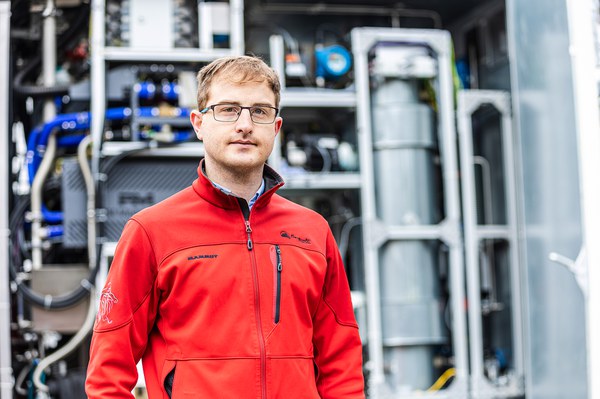The LOHC One Reactor will give rise to the world's largest facility for stationary and reversible hydrogen storage based on LOHC technology
Jülich, January 15, 2025 - The LOHC One Reactor will be delivered to the Jülich campus today, Wednesday, representing an important building block for research into innovative technologies for the future energy supply. This will give rise to a new type of hydrogen storage facility at Jülich, which is scheduled to go into research operation in 2026.

The new LOHC One Reactor is designed to help solve a crucial efficiency problem. “Hydrogen can be chemically bound in the LOHC* carrier liquid and then transported and stored safely and compactly. However, a lot of heat energy is needed to separate the valuable gas from the LOHC again later,” explains Dr. Michael Geißelbrecht from HI ERN, a branch office of Forschungszentrum Jülich in Erlangen-Nuremberg. The hydrogen expert and his team want to use the LOHC One Reactor to investigate and demonstrate how this can be done more efficiently.
* Liquid-organic hydrogen carrier
What makes the new facility particularly innovative is that it will be intelligently connected to the thermal energy centre (WVVZ), which has been heating the Jülich campus since 2023. When hydrogen is stored in the LOHC, heat is generated which can then be used in Jülich’s heating network. This means that less heat needs to be generated in the WVVZ, leading to energy savings. “In order to release our hydrogen from the LOHC again, we then slightly increase the output in the WVVZ to produce more heat,” says Geißelbrecht. “The aim is to keep the energy balance almost even – and thus increase the efficiency of releasing the hydrogen from its bound state. This can make LOHC technology even more attractive for applications such as seasonal energy storage.”
Largest facility of its kind in the world

The 34-year-old chemical engineer has scientific responsibility for the LOHC One Reactor, which is being built as part of the Living Lab Energy Campus (LLEC) project and will be housed in five container elements right next to the WVVZ. “At 7 by 9 meters, our new facility will be the largest of its kind in the world,” says Geißelbrecht. “It has taken years of development and required real pioneering work – not only for us researchers and the specialist companies involved in construction, but also for TÜV, which first had to develop its own expertise in LOHC systems.”
Geißelbrecht also works closely with Building and Engineering Services (T), which is responsible for the WVVZ, as well as colleagues from Planning and Building Services (B) and Intelligent Campus (TB-X). The team also includes operating engineer Martin Sengewald from INW, who is responsible for the safe and successful operation of the LOHC One Reactor. Sengewald, a mechanical engineer, has been preparing for this new responsibility at Jülich since June 2022. “I also learned a lot from the first smaller prototype at the Jülich branch office in Erlangen-Nuremberg, which has already been successfully operated there,” says the 45-year-old.

Outlook: Hydrogen pipeline
The containers that have already been delivered and the components already in storage on the BAW site will now be assembled over the next few weeks. In the coming months, tanks for the LOHC liquid, pumps, and other components will also be delivered. “Initially, the hydrogen will be delivered from an external supplier,” reports Sengewald. “But because our facility processes around 9 kilograms of hydrogen per hour, we need an internal supply for optimum operation.” A pipeline, which is also being built as part of the LLEC project and should be ready in about two years, will then be able to supply the LOHC One Reactor with hydrogen that is already being produced as part of research into electrolyzers at nearby IET-4.
Global vision for climate protection
If the LOHC One Reactor at Jülich is successful, it could also be integrated into the hydrogen demonstration region as part of the process of structural change in the Rhenish mining area. “Innovations like this are incredibly important for the energy transition,” says Geißelbrecht. “A well-researched and mature system would provide us with a great technology for safely storing green hydrogen in a stationary manner and using it to compensate for dunkelflaute periods when the level of solar and wind power generation is very low, as well as seasonal fluctuations.” Geißelbrecht’s global vision goes even further: it involves “LOHC storage in places that are ideally suited to renewable electricity – such as sunny Africa or windy Scotland – to produce green hydrogen there and transport it safely around the world thanks to LOHC. With facilities such as our new reactor, the hydrogen could then be released from the LOHC in a cost-effective manner in industrial plants, for example, where a lot of waste heat is generated anyway. In this way, Forschungszentrum Jülich could make a major contribution to climate protection.”
Why “reactor”?
The LOHC One Reactor is a chemical reactor, i.e. a pressure vessel in which the facility’s chemical reactions take place safely – monitored by a wide range of sensors. Inside this reaction chamber is a bundle of numerous tubes containing a catalyst for storing hydrogen in the non-flammable LOHC liquid and releasing it again. These tubes are cooled with thermal oil when the hydrogen is stored and reheated when it is released. The valuable carrier liquid can be used over and over again – similar to a refillable bottle.
Further Information
Living Lab Energy Campus (LLEC) website
LLEC blog in FZJ’s Jülich blogs
“effzett” magazine 2/2022: Cover story on the LLEC

